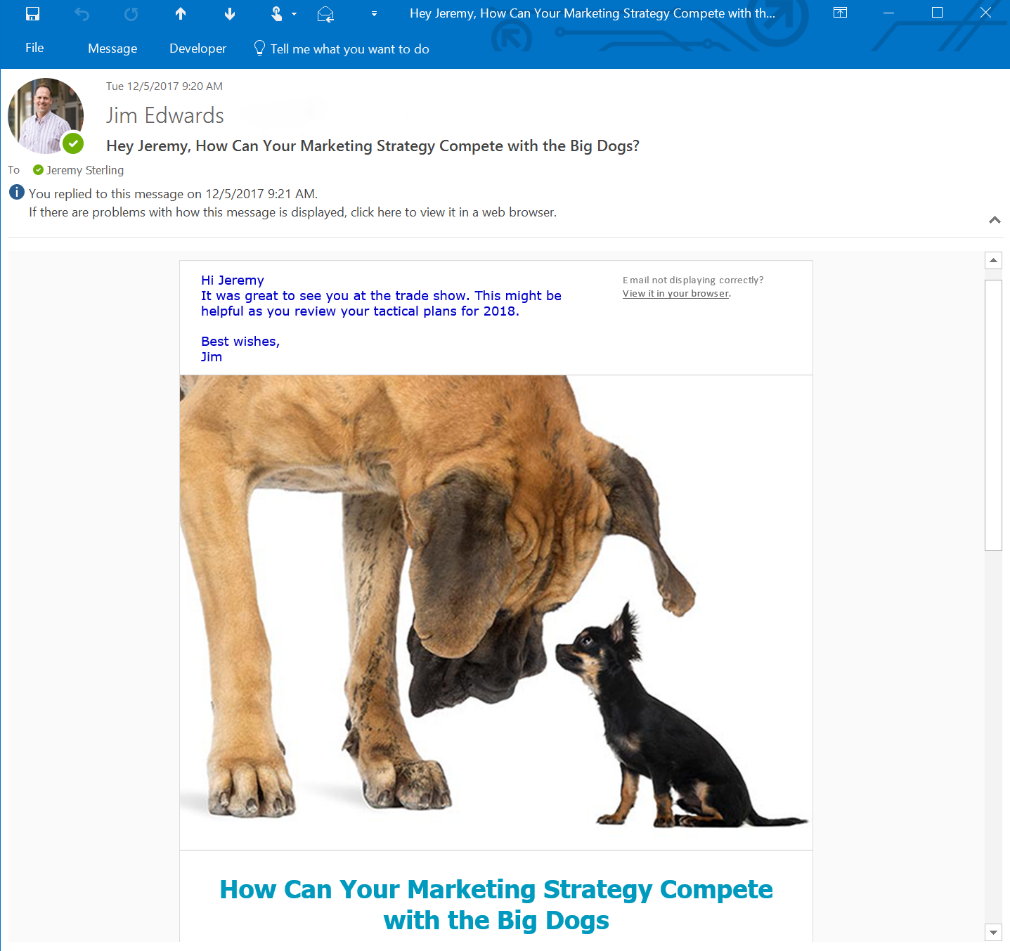
At the risk of sounding a bit nostalgic, does anyone else remember when getting email was exciting?
Once upon a time, that pleasant voice announced, “You’ve got mail!” and I was anxious to see what had magically popped into the inbox.
Alas, the thrill is gone.
These days, our inboxes are overloaded.
The number of emails sent per day in 2017 averaged 269 billion, and nearly half is spam.
Receiving new email elicits more groans than smiles these days.
But despite our overflowing inboxes, 86 percent of professionals name email as their favorite mode of communication.
And it continues to be a highly effective marketing tool.
Consider these statistics:
- Ninety-three percent of B2B marketers use email to distribute content
- Seventy-five percent of marketers agree that email offers “excellent” to “good” ROI
- Segmented and targeted emails generate 58 percent of all revenue
The fact is, email marketing garners results because it is targeted, measurable, and cost-effective.
The Direct Marketing Association estimates email marketing brings in $40 for every $1 spent. Not bad, right?
Where Everybody Knows Your Name
Of course, this is not your father’s email.
We no longer blast generic messages and hope for the best.
Thanks to new technology, such as marketing automation, we can personalize messages catering to audience interests and their interaction with our website or other content.
The biggest benefit of personalized email marketing is the ability to provide the reader with the most valuable information at an optimal time in the buying process.
As a result, you move a prospect from awareness to consideration to a decision.
Five years ago, I would have been shocked (and a little freaked out) to receive an email from a company addressed, “Hey, Jim.”
Or an email noting the fact I recently paid a visit to their website and read one of their white papers.
Today, I would be surprised to receive email without my name, or content tailored to my interests and interactions.
Like Cliff and Norm from Cheers (there I go getting all nostalgic again), people like to feel special.
Email Personalization Works
This is why email personalization works.
In addition, we all suffer from “information excess,” making it impossible to read every email we receive.
(How many emails do you delete without bothering to open?)
On the other hand, emails with personalized subject lines are 26 percent more likely to be opened.
And, personalized email messages improve click-through rates by an average of 14 percent and conversions by 10 percent.
As marketers, when we see those results, we tend to adopt new techniques faster than Norm can chug a beer.
However, simply following trends is not enough – marketers must think (and plan) before going all in.
The Right Way to Get Personal with Email Marketing
As we strive to leverage personalization, make emails stand out among the clutter, and improve click-through rates, there are some “best practices” to consider:
- Don’t be a robot
- Personalize
- Check for mistakes
- Use dynamic content thoughtfully
- Consider the time of day
- Proofread, test, and monitor
Let’s explore each one.
Robots Are Not Humans
A danger of automation, especially with communication, is sounding “robotic.”
Maintain actual human interaction within your email marketing campaign.
You can accomplish this by:
- Sending notifications to salespeople to stimulate direct outreach via phone to warm leads.
- Using phone interaction to collect additional data needed for qualification.
- Making sure to craft automated emails in a personable manner. Watch the formal language (people only call me James when I am in trouble). Write in the first-person, as though you are talking to someone. Avoid jargon and buzzwords.
- Designing “Outlook-style” text emails instead of designed HTML emails. Give them the feel of coming from a human account.
Email Marketing Should Be Personalized
For instance, a personalized email sent from “info@mycompanyname.com” tells the customer that it’s not a real email from “Jim.”
Likewise, if drip emails are coming from an assigned user, make sure the “reply to” addresses are all from that user.
Check for Mistakes
Manage the default or override values within your variable tags.
That’s technical jargon for “check for mistakes!”
Search your list for omitted field values and resolve missing data.
Create dynamic content to override missing field data.
For example, “Dear Jim” overrides to say “Dear Friend.”
Or, “We would love to do business with Ford.” becomes “We would love to do business with your company.”
Thoughtful Dynamic Content
Speaking of dynamic content, use it thoughtfully.
Dynamic content allows you to determine who sees what content for each block of content within an email.
This means you can show different email content to different segments or lists for a specific campaign.
Consider the Time of Day
Nothing shouts “automated” louder than sending emails during the wee hours of the morning.
Ideally, send emails during normal work hours.
And be sure to set your deployment technology to the correct time zone.
Marketing automation platforms allow you to adjust the time an email is sent according to the user who sends it.
So, email sent from a West Coast sales rep uses Pacific Time, while the New York sale rep sends email using Eastern Time.
Proofread, Test, and Monitor
Proofread and test emails before sending.
Spot check sent emails for errors in the communication and sending snafus which you can correct.
These types of missteps make you look unprofessional and impersonal.

Source: Spry Ideas
Conclusion
In today’s tech world, we expect personalized communication.
As savvy marketers, we recognize automated and tailor-made email (or that of a creepy stalker).
Marketers are becoming more granular regarding targeting and efforts to cut through an increasing amount of content.
Therefore, it is worth making the extra effort to be authentic and develop truly personal relationships you can build on.
After all, that is the goal of content marketing.